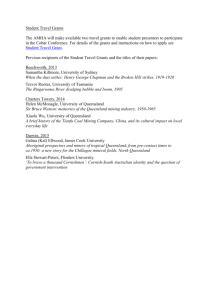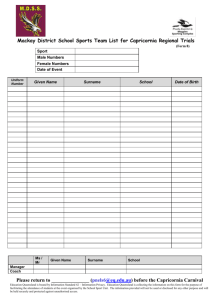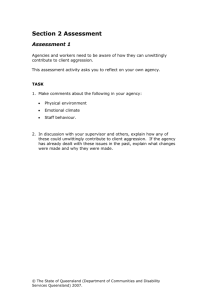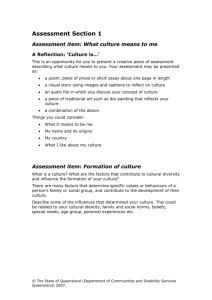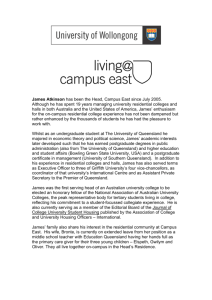Food Safety Matters: PowerPoint Presentation
advertisement
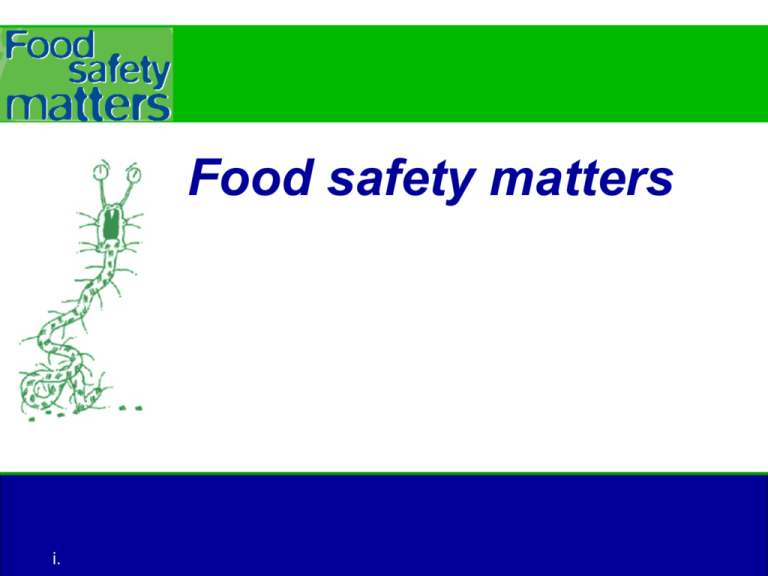
Food safety matters i. Presentation outline Food poisoning – what is it? Types of food contamination Factors contributing to food poisoning outbreaks Strategies to prevent food poisoning ii. © Queensland Health Food poisoning Illness from consuming food that contains a harmful substance, harmful micro-organisms or their toxins. Approximately 5.4 million cases per year in Australia*. Common symptoms: – stomach aches – vomiting – diarrhoea – fever. Can result in long-term diseases and death. Often caused by food that looks, smells and tastes normal. 1. *Based on research by OzFoodNet, released by the Australian Government Department of Health and Ageing in 2003. © Queensland Health Types of food contamination Food can be contaminated by: – chemicals – natural toxins – foreign matter – organisms. 2. © Queensland Health Chemicals Chemicals in the home include those used: – to clean kitchen surfaces and equipment – as pesticides. Chemicals can be very harmful if they are: – spilt on or near food – mistaken for food or drink. 3. © Queensland Health Natural toxins Toxins are poisonous substances produced by some micro-organisms, plants and animals. Most toxins that cause food poisoning are tasteless and remain dangerous when cooked. 4. © Queensland Health Foreign matter Foreign matter can: – physically injure people – introduce harmful bacteria into food. Examples of foreign matter include: – – – – – 5. dead insects hair jewellery glass pieces of metal. © Queensland Health Organisms The organisms that can make us sick include: – – – – viruses bacteria parasites mould. Micro-organisms such as viruses and bacteria are the most common causes of food poisoning. 6. © Queensland Health Factors contributing to food poisoning outbreaks 1980 - 1995 Poor personal hygiene 9% Unsafe food source 19% Contaminated equipment 19% 7. Other 6% Inadequate cooking 27% Temperature control 20% Source: Crerar, S.K. et al 1996 © Queensland Health The food poisoning time bomb 8. © Queensland Health Strategies to prevent food poisoning To ensure food does not become contaminated: 1. Keep hands and nails clean 2. Keep the kitchen clean 3. Handle food safely. To kill or slow down the growth of micro organisms: 4. Cook high-risk foods thoroughly 5. Keep hot food hot and cold food cold. 9. © Queensland Health Keeping hands and nails clean We need to: wash hands and nails thoroughly with warm, running water and soap dry hands thoroughly cover cuts and infections on hands. 10. © Queensland Health Washing hands and nails thoroughly with warm, running water and soap We should wash our hands: before eating, preparing or handling food between handling raw meat, poultry and seafood, and handling cooked food or food that will be eaten raw after coughing and sneezing, using a handkerchief etc after going to the toilet after handling rubbish after touching animals after handling chemicals (e.g. cleaning products). 11. © Queensland Health Transfer of micro-organisms by hands 12. © Queensland Health Keeping the kitchen clean When cleaning plates and equipment, we need to: scrape and rinse off surface food wash in clean, soapy water rinse in clean water air dry where possible if drying immediately, use only a clean, dry towel. 13. © Queensland Health Keeping the kitchen clean: Pest control and animals We need to: stop pests such as cockroaches and mice coming into the area where food is kept discourage pests by not leaving food or dirty dishes out on the benches keep animals out of the kitchen. 14. © Queensland Health Handling food safely We need to: avoid preparing food when sick or feeling unwell keep raw meats, poultry and seafood separated from cooked food and food to be eaten raw protect food in the refrigerator by placing in covered containers or covering with plastic wrap use clean equipment, plates or containers to prevent contamination of cooked food (or food that will be eaten raw) with traces of raw food 15a. © Queensland Health Handling food safely (continued) We need to: use clean equipment, rather than hands, to pick up food wear clean clothes or a clean apron wash fruit and vegetables to be eaten raw under running water. 15b. © Queensland Health Cooking high-risk foods thoroughly We need to cook thoroughly food such as: mince burger patties sausages rolled roasts stuffed meats rabbit seafood poultry. 16. © Queensland Health Keeping hot food hot and cold food cold Bacteria die Avoid keeping food in the temperature danger zone of 5°C - 60°C Bacteria grow Bacteria stop growing 17. © Queensland Health Keeping hot food hot Avoid keeping food in the temperature danger zone of 5°C - 60°C. We need to: keep cooked food at 60°C or above until served refrigerate or freeze food that is to be prepared well in advance and reheat until steaming hot before serving cook or reheat packaged food strictly in accordance with any directions on the label. 18. © Queensland Health Keeping cold food cold Avoid keeping food in the temperature danger zone of 5°C - 60°C. We need to: take cold groceries home to the refrigerator quickly as possible keep chilled and frozen food cold if it will be a long time before it can be placed in a refrigerator or freezer store cold food at 5°C or less keep cold food in the refrigerator as much as possible thaw frozen food in the refrigerator or microwave store and handle cold food according to any directions on the label check the temperature of the refrigerator regularly. 19. © Queensland Health Summary: Preventing food poisoning in the home We need to: 1. keep hands and nails clean 2. keep the kitchen clean 3. handle food safely 4. cook high-risk foods thoroughly 5. keep hot food hot and cold food cold. 20. © Queensland Health


